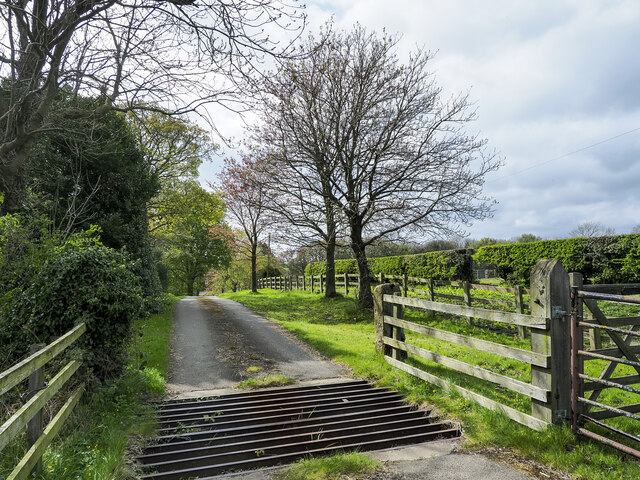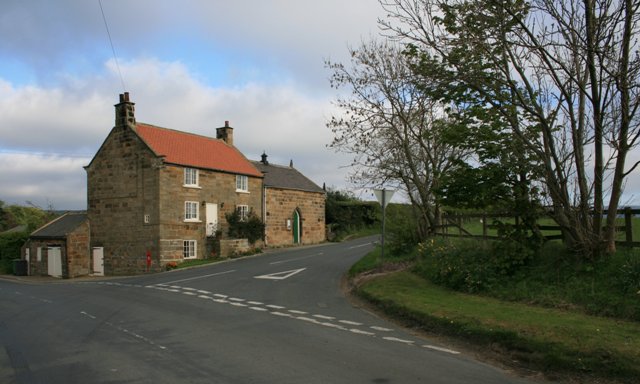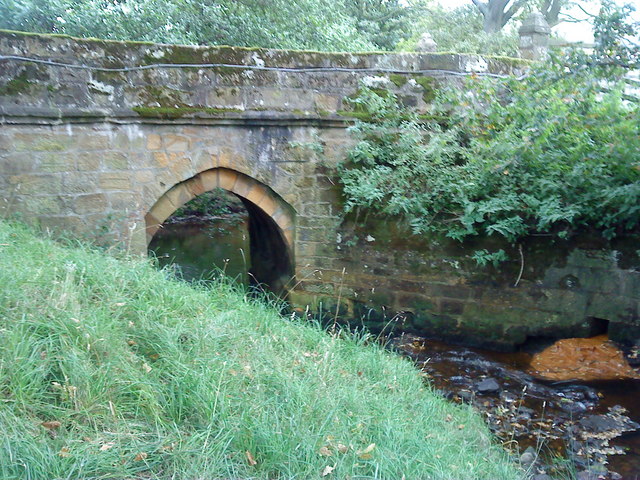Alder Covert
Wood, Forest in Yorkshire Hambleton
England
Alder Covert
![A block of dressed sandstone with holding down bolts Hidden away in the forestry above Bank Foot is a tramway incline that served the sandstones quarries higher on Greenhow Bank. It first appears on the 1893 OS 25 inch map.
Blocks of sandstone would have been lowered down to a siding by the Rosedale Ironstone railway. I guess here a bridge was built to allow the incline to pass carrying an existing track. The line of the incline can be followed quite easily.
The lowest of these quarries is at 230m level. Here the incline branches, one climbs to a quarry at 330m level, the main incline to one at 290m. The 330m quarry was the subject of a post in 2015.
It is tempting to assume that these quarries, which seem to have been used entirely for building stone were operated by the Ingleby Ironstone & Freestone Company which built the original three mile long narrow gauge line to their ironstone mine at Rudd Scar. However, that mine was abandoned in 1860. Their narrow gauge railway had by then been upgraded to standard gauge by the North Yorkshire and Cleveland Railway.
For sources and references see my blog: Out and about ... (2021). Park Plantation Quarry Tramway. [online] Available at: <span class="nowrap"><a title="http://www.fhithich.uk/?p=24999" rel="nofollow ugc noopener" href="http://www.fhithich.uk/?p=24999">Link</a><img style="margin-left:2px;" alt="External link" title="External link - shift click to open in new window" src="https://s1.geograph.org.uk/img/external.png" width="10" height="10"/></span> [Accessed 11 Dec. 2021].
Update 26/12/21
The quarry was operated by the Ingleby Stone Quarry Company, a company probably under the direction of a Mr. Wren. The stone was lowered down to the Rosedale Railway by an incline known as Wren&#039;s Incline see [The Gazette. (1883). Page 6651 | Issue 25299, 25 December 1883 | London ... [online] Available at: <span class="nowrap"><a title="https://www.thegazette.co.uk/London/issue/25299/page/6651/data.htm" rel="nofollow ugc noopener" href="https://www.thegazette.co.uk/London/issue/25299/page/6651/data.htm">Link</a><img style="margin-left:2px;" alt="External link" title="External link - shift click to open in new window" src="https://s1.geograph.org.uk/img/external.png" width="10" height="10"/></span> [Accessed 22 Oct. 2021].].
In 1866, it was reported that a Mr Wren (the same?) had opened an ironstone mine in the area which was &quot;soon afterwards abandoned&quot; [&#039;The Cleveland Ironstone&#039; (1866) Yorkshire Gazette, 25 Aug, 4, available: <span class="nowrap"><a title="https://link-gale-com.ezproxy.is.ed.ac.uk/apps/doc/JF3231098185/GDCS?u=ed_itw&amp;sid=bookmark-GDCS&amp;xid=baf2da3d" rel="nofollow ugc noopener" href="https://link-gale-com.ezproxy.is.ed.ac.uk/apps/doc/JF3231098185/GDCS?u=ed_itw&amp;sid=bookmark-GDCS&amp;xid=baf2da3d">Link</a><img style="margin-left:2px;" alt="External link" title="External link - shift click to open in new window" src="https://s1.geograph.org.uk/img/external.png" width="10" height="10"/></span> [accessed 26 Dec 2021].]. This must be referring to the Ingleby Manor ironstone mine which briefly operated between 1856 and 1860 [Tuffs, Peter. &quot;Catalogue of Cleveland Ironstone Mines&quot;. Page 17. Cleveland Ironstone Series 1996.]. The mine had been developed with high hopes, having expectations of an annual yield of 150,000 tons [&#039;News&#039; (1857) Newcastle Journal, 12 Dec, 8, available: <span class="nowrap"><a title="https://link-gale-com.ezproxy.is.ed.ac.uk/apps/doc/GR3216193104/GDCS?u=ed_itw&amp;sid=bookmark-GDCS&amp;xid=711c2fad" rel="nofollow ugc noopener" href="https://link-gale-com.ezproxy.is.ed.ac.uk/apps/doc/GR3216193104/GDCS?u=ed_itw&amp;sid=bookmark-GDCS&amp;xid=711c2fad">Link</a><img style="margin-left:2px;" alt="External link" title="External link - shift click to open in new window" src="https://s1.geograph.org.uk/img/external.png" width="10" height="10"/></span> [accessed 26 Dec 2021].].](https://s3.geograph.org.uk/geophotos/07/04/11/7041191_d10cbe10.jpg)
Alder Covert is a picturesque woodland area located in the county of Yorkshire, England. Situated amidst the serene beauty of nature, this charming forest is known for its dense growth of alder trees that dominate the landscape.
Covering an expansive area, Alder Covert offers a peaceful retreat away from the hustle and bustle of city life. The forest boasts a diverse range of flora and fauna, making it a haven for nature enthusiasts and wildlife lovers. Visitors can expect to see a variety of bird species, such as woodpeckers and owls, as well as small mammals like squirrels and rabbits.
Walking trails wind their way through the forest, allowing visitors to explore its hidden gems. The paths are well-maintained, making it easy for hikers and walkers to navigate the terrain. Along the way, one can discover enchanting clearings, babbling brooks, and even a small pond, adding to the overall charm of the woodland.
The quiet and tranquil atmosphere of Alder Covert makes it an ideal spot for those seeking solace and relaxation. It is a popular destination for picnickers, who can find a peaceful spot under the shade of the alder trees to enjoy a meal amidst the serenity of nature.
Alder Covert is open to the public year-round and offers a truly enchanting experience for all who visit. Whether you're a nature lover, a wildlife enthusiast, or simply seeking a peaceful retreat, this woodland gem in Yorkshire is sure to captivate your senses and leave you with a lasting impression of its natural beauty.
If you have any feedback on the listing, please let us know in the comments section below.
Alder Covert Images
Images are sourced within 2km of 54.448856/-1.0874451 or Grid Reference NZ5906. Thanks to Geograph Open Source API. All images are credited.
![A block of dressed sandstone with holding down bolts Hidden away in the forestry above Bank Foot is a tramway incline that served the sandstones quarries higher on Greenhow Bank. It first appears on the 1893 OS 25 inch map.
Blocks of sandstone would have been lowered down to a siding by the Rosedale Ironstone railway. I guess here a bridge was built to allow the incline to pass carrying an existing track. The line of the incline can be followed quite easily.
The lowest of these quarries is at 230m level. Here the incline branches, one climbs to a quarry at 330m level, the main incline to one at 290m. The 330m quarry was the subject of a post in 2015.
It is tempting to assume that these quarries, which seem to have been used entirely for building stone were operated by the Ingleby Ironstone &amp; Freestone Company which built the original three mile long narrow gauge line to their ironstone mine at Rudd Scar. However, that mine was abandoned in 1860. Their narrow gauge railway had by then been upgraded to standard gauge by the North Yorkshire and Cleveland Railway.
For sources and references see my blog: Out and about ... (2021). Park Plantation Quarry Tramway. [online] Available at: <span class="nowrap"><a title="http://www.fhithich.uk/?p=24999" rel="nofollow ugc noopener" href="http://www.fhithich.uk/?p=24999">Link</a><img style="margin-left:2px;" alt="External link" title="External link - shift click to open in new window" src="https://s1.geograph.org.uk/img/external.png" width="10" height="10"/></span> [Accessed 11 Dec. 2021].
Update 26/12/21
The quarry was operated by the Ingleby Stone Quarry Company, a company probably under the direction of a Mr. Wren. The stone was lowered down to the Rosedale Railway by an incline known as Wren&#039;s Incline see [The Gazette. (1883). Page 6651 | Issue 25299, 25 December 1883 | London ... [online] Available at: <span class="nowrap"><a title="https://www.thegazette.co.uk/London/issue/25299/page/6651/data.htm" rel="nofollow ugc noopener" href="https://www.thegazette.co.uk/London/issue/25299/page/6651/data.htm">Link</a><img style="margin-left:2px;" alt="External link" title="External link - shift click to open in new window" src="https://s1.geograph.org.uk/img/external.png" width="10" height="10"/></span> [Accessed 22 Oct. 2021].].
In 1866, it was reported that a Mr Wren (the same?) had opened an ironstone mine in the area which was &quot;soon afterwards abandoned&quot; [&#039;The Cleveland Ironstone&#039; (1866) Yorkshire Gazette, 25 Aug, 4, available: <span class="nowrap"><a title="https://link-gale-com.ezproxy.is.ed.ac.uk/apps/doc/JF3231098185/GDCS?u=ed_itw&amp;sid=bookmark-GDCS&amp;xid=baf2da3d" rel="nofollow ugc noopener" href="https://link-gale-com.ezproxy.is.ed.ac.uk/apps/doc/JF3231098185/GDCS?u=ed_itw&amp;sid=bookmark-GDCS&amp;xid=baf2da3d">Link</a><img style="margin-left:2px;" alt="External link" title="External link - shift click to open in new window" src="https://s1.geograph.org.uk/img/external.png" width="10" height="10"/></span> [accessed 26 Dec 2021].]. This must be referring to the Ingleby Manor ironstone mine which briefly operated between 1856 and 1860 [Tuffs, Peter. &quot;Catalogue of Cleveland Ironstone Mines&quot;. Page 17. Cleveland Ironstone Series 1996.]. The mine had been developed with high hopes, having expectations of an annual yield of 150,000 tons [&#039;News&#039; (1857) Newcastle Journal, 12 Dec, 8, available: <span class="nowrap"><a title="https://link-gale-com.ezproxy.is.ed.ac.uk/apps/doc/GR3216193104/GDCS?u=ed_itw&amp;sid=bookmark-GDCS&amp;xid=711c2fad" rel="nofollow ugc noopener" href="https://link-gale-com.ezproxy.is.ed.ac.uk/apps/doc/GR3216193104/GDCS?u=ed_itw&amp;sid=bookmark-GDCS&amp;xid=711c2fad">Link</a><img style="margin-left:2px;" alt="External link" title="External link - shift click to open in new window" src="https://s1.geograph.org.uk/img/external.png" width="10" height="10"/></span> [accessed 26 Dec 2021].].](https://s3.geograph.org.uk/geophotos/07/04/11/7041191_d10cbe10.jpg)



Alder Covert is located at Grid Ref: NZ5906 (Lat: 54.448856, Lng: -1.0874451)
Division: North Riding
Administrative County: North Yorkshire
District: Hambleton
Police Authority: North Yorkshire
What 3 Words
///clutter.select.sprouted. Near Ingleby Greenhow, North Yorkshire
Nearby Locations
Related Wikis
Battersby
Battersby is a hamlet in North Yorkshire, England. It lies on the edge of the North York Moors National Park and within the historic boundaries of the...
Battersby railway station
Battersby is a railway station on the Esk Valley Line, which runs between Middlesbrough and Whitby via Nunthorpe. The station, situated 11 miles 4 chains...
Ingleby Greenhow
Ingleby Greenhow is a village and civil parish in the Hambleton district of North Yorkshire, England. It is on the border of the North York Moors and 3...
Ingleby railway station
Ingleby railway station was a railway station built to serve the village of Ingleby Greenhow in North Yorkshire, England. The station was on the North...
Easby, Hambleton
Easby is a village and civil parish in Hambleton District of North Yorkshire, England. It lies approximately 2 miles (3.2 km) south-east of Great Ayton...
Basedale Priory
Basedale Priory or Baysdale Priory was a priory in North Yorkshire, England located 8 miles (13 km) East from the parish church of Stokesley. It was a...
Kildale railway station
Kildale is a railway station on the Esk Valley Line, which runs between Middlesbrough and Whitby via Nunthorpe. The station, situated 12 miles 65 chains...
Easby Moor
Easby Moor is a hill located in the civil parish of Little Ayton in the North York Moors national park within the Cleveland Hills, North Yorkshire, England...
Nearby Amenities
Located within 500m of 54.448856,-1.0874451Have you been to Alder Covert?
Leave your review of Alder Covert below (or comments, questions and feedback).





















